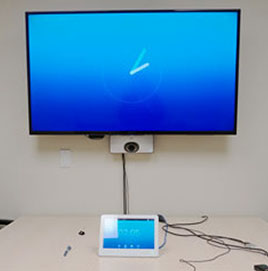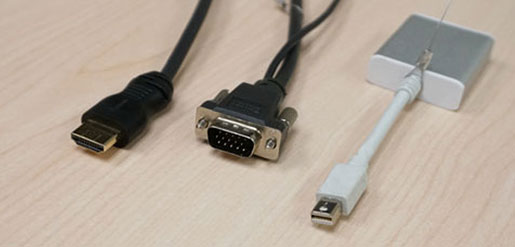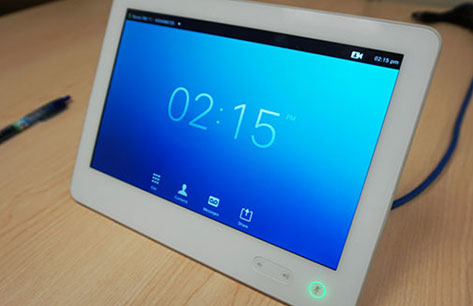Audiovisual equipment
Purpose: The purpose of this document is to unify the terms used to identify AV equipment used across Stanford.
References: All references in a room are made from the perspective of a user facing the front of the room. A display on the user's left, but the presenter's right, should be referred to as the "left display."
Audio equipment
- Conference phone
- A phone that is enabled for audio conferencing with one or more people.
-
Microphone

-
Equipment that captures audio in the room. A microphone also allows onsite users to speak to remote users. A microphone can be mounted or hidden on the left or right of the audience, or on the ceiling.
- Speakers
- Equipment that projects audio. Speakers also allow onsite users to hear remote users. Speakers can be mounted or hidden on the left or right of the audience, on the ceiling, or built into the display.
Furniture
- AV Cart
- Mobile furniture that typically has a display attached.
- Credenza
- A sideboard (narrow table) placed along one wall.
- Lectern
- A tall, narrow piece of furniture used to hold a presenter’s notes or equipment. A lectern might have a control panel, a touch panel, or both of these.
- Table
- The piece of furniture that people sit around, which typically holds equipment in many audiovisual rooms.
Visual equipment
-
Camera

-
Equipment that captures video in the room. A camera is also used to show participants in a conference room.
- Confidence monitor
- A display at the back of the room that is in plain sight for the presenter; typically used to ensure that the presentation slides are accurate.
-
Displays

-
TV-like monitors, not projection screens, attached to a wall or other object. Identify the location of multiple displays from the viewpoint of the audience looking at the presenter. These displays can be located:
- On the left or right side of the room.
- At the top or bottom of a wall.
- In the front or back of the room.
- Document Camera
- A visual presenter that captures images real-time and displays the images on a board, screen, or display for the audience.
- Interactive display/video wall
- Touch-enabled wall-mounted displays that a user can interact with.
- Lectern display
- A display built into a podium.
- Projector
- Equipment used to project a series of slides or videos onto a screen or wall. A projector can be mounted to the left or right of an audience, at the top or bottom of a room, or on a table in a room.
Peripheral equipment
- Cabling
- Cables used to connect audiovisual equipment. All cables are labeled by industry name (such as “VGA cable”) with stickers.
-
Dongles

-
Equipment used to convert a cable to a port on your device, such as to convert a VGA cable to a Mini DisplayPort. All dongles are labeled by name with stickers.
Controls
- Control panel
-
A panel with raised buttons used to control the room machine and other audiovisual equipment. A control panel can be built into a podium or a wall.
- Light panel
- A panel used to control lights in the room.
- Room machine
- A PC or Macintosh in the room. The machine can be connected to a control panel or touch panel.
- Screen control
- A button or option that raises and lowers a screen. A screen control is usually built into a control panel or a touch panel.
-
Touch panel

-
A panel with a flat touchscreen used to control the room machine and other audiovisual equipment. A touch panel can be built into a podium, a wall, or rest on the table.
